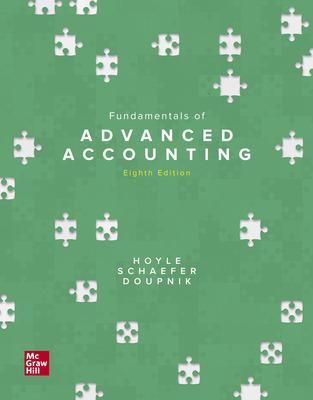Question
1.What is the primary difference between a manufacturer and a merchandiser? a.Merchandisers purchase finished goods ready to sell, whereas a manufacturer must create the goods.
1.What is the primary difference between a manufacturer and a merchandiser?
a.Merchandisers purchase finished goods ready to sell, whereas a manufacturer must create the goods.
b.Merchandisers are retailers, while manufacturers are service providers
c.Merchandisers do not sell directly to the public, but rather only to manufacturers.
d.Manufacturers buy the finished goods from a merchandiser then resell it, basically acting as a middle man.
2.Limited liability is a benefit for the owners of:
a.sole proprietorships.
b.partnerships.
c.company/corporation.
d.sole proprietorships and partnerships.
3.The Board of Directors makes business decisions for:
a.sole proprietorships.
b.partnerships.
c.company/corporation.
d.all forms of businesses.
6. Management accounting information:
a.is a one size fits all approach to reporting business results.
b.can be tailored to the needs of the internal user.
c.is used by lenders to make credit decisions.
d.helps shareholders make decisions.
7. When calculating the closing balance of owner's equity for a business, which of the following should be added to beginning owner's equity?
a.Net income and owner's contributions
b.Assets and liabilities
c.Assets and owner's contributions
d.Owner's contributions and owner's withdrawals
8.Which of the following is the correct order of the four stages of the critical thinking process?
a.Recognise problem, identify alternatives, evaluate alternatives, make decision
b.Identify alternatives, evaluate alternatives, solve problem, evaluate solution
c.Identify alternatives, evaluate alternatives, make decision, evaluate decision
d.Recognise problem, identify alternatives, solve problem, evaluate solution
9.Investors and creditors have the following two related concerns when they are making investment and credit decisions:
a.sales and profit.
b.performance and position.
c.risk and return.
d.environment and return.
10.The financial plan describes the projected financial performance and:
a.shows how the business will respond to market conditions.
b.how the business will develop its products or services.
c.identifies capital requirements and sources of capital.
d.provides evidence of demand for products or services.
11.Which of the following best represents an example of a fixed cost?
a.Equipment.
b.Cost of products sold to customers.
c.Salary plus commission employees.
d.Telephone usage.
12.Total variable costs:
a.do not respond to changes in volume.
b.move in the opposite direction to changes in volume.
c.change in direct proportion with changes in volume.
d.will always be the same from one period to the next.
13. Which of the following costs change directly in proportion to sales volume?
a.Both fixed costs and variable costs.
b.Total variable costs.
c.Contribution margin per unit.
d.Fixed costs.
14.The profit equation for a given sales volume is:
a.[Selling price per unit x volume] + [variable cost per unit x volume] - total fixed costs.
b.[Selling price per unit x volume] - [break even point] - total fixed costs.
c.[Selling price per unit x volume] + [break even point] + total fixed costs.
d.[Selling price per unit x volume] - [variable cost per unit x volume] - total fixed costs.
15.Barb's Best Pies sells a meat pie for $5.00. Variable costs are $3.00 per unit and fixed costs for the period are $4000. The profit on the 2001st pie sold is:
a.$2.00.
b.$5.00.
c.$3.00.
d.$ - 0 -.
16.Widget World makes a widget that is sells for $10 per unit. The variable costs are $7 per unit. Assuming the business has normal fixed costs, and the break-even point is 350 units, what are the total costs at break even?
a.$4500.
b.$3500.
c.$12 000.
d.$7500.
17.The three broad forms of business structure include all of the following except:
a.Sole proprietorships
b.Dual proprietorships
c.Partnerships
d.Companies / corporations
18.The accounting equation:
a.requires equilibrium of resources and the claims on those resources.
b.requires at least one entry to record a transaction.
c.provides the structure for the income statement.
d.is another name for the balance sheet.
19.The dual effect of transactions means:
a.every transaction affects both assets and either liabilities or owners' equity.
b.every transaction affects either assets or liabilities.
c.every transaction affects both assets and owners' equity.
d.every transaction affects at least two accounts.
20.Which of the following best describes an application of accrual accounting?
a.Recording expenses in the same accounting period in which the liability was paid.
b.Recording expenses in the same accounting period in which the expense was matched to assets.
c.Recording expenses in the same accounting period in which the expense was paid.
d.Recording expenses in the same accounting period in which the expense was incurred.
21.The end of period adjustment to record interest on a note payable accumulated, but not yet paid for the period , paid would require:
a.Increasing expenses and increasing liabilities (note payable)
b.Increasing revenue and increasing liabilities (note payable).
c.Increasing assets and increasing owner's equity.
d.Increasing owner's equity and decreasing assets.
22.An income statement normally includes all of the following except:
a.Revenue.
b.Expenses.
c.Net income.
d.Owner's Equity.
23.Accounts for ABC Pte Ltd are as follows:
Bank overdraft $ 2,000
Accounts payable $10,000
Accounts receivable $11,700
Office equipment $ 4,500
Loan (1 year term) $14,000
Machinery $32,000
Total Assets amount is ____________________
Total Liabilities amount is _________________
The following information is for questions 24 to 27.
ABC's cake has a variable costs of $2 per unit and fixed costs is $45,000 and selling price is $5.
24. What is the breakeven point in units?
_________________
25. How many units must ABC sell to earn a profit of $100,000?
_________________
26. How much profit will ABC earn if it cuts its selling price to $3 per unit and sells 100,000 units?
_________________
Step by Step Solution
There are 3 Steps involved in it
Step: 1

Get Instant Access to Expert-Tailored Solutions
See step-by-step solutions with expert insights and AI powered tools for academic success
Step: 2

Step: 3

Ace Your Homework with AI
Get the answers you need in no time with our AI-driven, step-by-step assistance
Get Started


